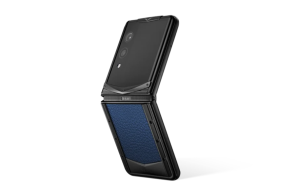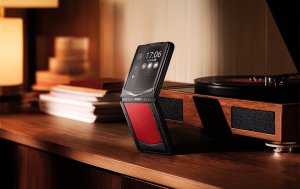In 2025, 5G technology is no longer a luxury for consumers—it's a critical infrastructure for businesses aiming to boost efficiency and optimize operations. For any enterprise focused on peak performance and a future competitive edge, upgrading to business 5G phones is not just an option, but a necessity.
Here’s a quick look at what you’ll learn:
-
How the ultra-high speed and low latency of 5G phones can revolutionize your business workflows.
-
The non-negotiable security features for enterprise 5G phones in 2025 to ensure your data is protected.
-
How to efficiently deploy and manage 5G devices using Enterprise Device Management (EDM) tools.
-
How on-device AI and edge computing on 5G phones can boost efficiency and protect data privacy.
-
The key criteria for selecting the best enterprise 5G phones, including Total Cost of Ownership (TCO) and durability.
How do 5G's Speed and Low Latency Impact Business?
The core advantages of a 5G network are its unparalleled speed and extremely low latency. For an enterprise, this translates into tangible performance gains. File transfers that once took minutes, such as large design files, HD video recordings, or complex financial reports, are completed in seconds. Your sales team on the road can access and update the CRM system in real-time, while field engineers can upload diagnostic data instantly, drastically cutting down response times. Employees can multitask seamlessly—joining HD video conferences, accessing cloud applications, and downloading large files simultaneously without any lag.
“5G is not just a faster network; it is the accelerator for enterprise digital transformation. It lays the foundation for real-time collaboration, AI-driven applications, and edge computing.” – Industry Analyst
Let's compare the performance difference between 4G and 5G in enterprise applications:
| Feature | 4G Network | 5G Network | Impact on Enterprise Applications |
| Peak Speed | Up to 100 Mbps | Up to 10 Gbps | Exponential improvement in large file transfers and cloud app responsiveness. |
| Latency | 50-100 ms | Sub-1 ms (theoretical) | Significant enhancement in real-time collaboration, remote control, and AR/VR applications. |
| Connection Density | ~100,000 devices/km² | ~1 million devices/km² | Enables massive IoT deployments, smart factories, and smart cities. |
| Energy Efficiency | Standard | More efficient (for connected devices) | Extends battery life and reduces maintenance costs for IoT devices. |
| Network Slicing | Not Supported | Supported | Provides dedicated, guaranteed network services for mission-critical applications. |
How Do 5G Phones Empower Remote and Hybrid Work?
As the hybrid work model becomes the new standard, 5G business phones provide the robust technological backbone to support it. Employees can enjoy crystal-clear, fluid video conferencing from anywhere, creating a feeling of face-to-face interaction. A 5G phone, paired with an external monitor and keyboard, can transform into a powerful, portable workstation. Furthermore, 5G's low latency makes augmented reality (AR) and virtual reality (VR) applications practical for product design, remote maintenance, and employee training, enhancing both collaboration and immersion.
What Security Features Are Non-Negotiable for Business 5G Phones in 2025?
In the age of enterprise mobility, data security is paramount. When selecting a business 5G phone, security features must be the top priority. This security should not be limited to software but must be rooted in the hardware itself. Look for features like Secure Boot, which ensures only verified software loads at startup, and a hardware encryption module (like a TPM or Secure Enclave) to protect sensitive data like encryption keys and biometrics. On the software side, ensure the manufacturer provides timely security patches and long-term OS updates to counter evolving cyber threats.
How Can Businesses Manage a Fleet of 5G Phones Effectively?
When deploying a large number of corporate 5G devices, efficient management is key to maintaining security and productivity. Enterprise Device Management (EDM) or Mobile Device Management (MDM) tools are indispensable. An EDM platform offers a centralized hub to automate device enrollment, uniformly configure settings like Wi-Fi and VPN, and enforce security policies such as password complexity and screen lock times. It also allows for the creation of an enterprise app store to safely deploy and update internal applications and provides crucial remote wipe/lock capabilities in case a device is lost or stolen.
How Do On-Device AI and Edge Computing Provide a Competitive Edge?
In 2025, business 5G phones are more than communication tools; they are powerful mobile computing platforms with integrated AI and edge computing. On-device AI enhances efficiency through intelligent voice assistants, real-time translation, and image analysis for tasks like inventory management. Edge computing brings data processing closer to the source, which drastically reduces latency for real-time applications and enhances data privacy by minimizing the need to send sensitive information to the cloud.
What is the True Cost of an Enterprise 5G Phone?
The purchase price is just one part of the equation. Businesses must evaluate the Total Cost of Ownership (TCO), which includes the initial hardware cost, deployment and configuration expenses, ongoing management and maintenance, 5G data plan fees, and potential costs from security incidents. A comprehensive TCO analysis provides a true financial picture and helps in making a sustainable investment decision.
Why are Durability and Ecosystem important for Enterprise Phones?
For business use, durability and ecosystem compatibility are critical. Look for phones with industrial-grade durability, such as IP ratings for water/dust resistance and MIL-STD ratings for drop protection, to minimize repair costs. Ensure the manufacturer offers a long-term software support commitment of at least 3-5 years. Finally, consider how the device integrates with your existing IT infrastructure, including EDM, CRM, and ERP systems, and its ability to work seamlessly with PCs and tablets.
What are the Real-World Impacts of 5G on Business Workflows?
The powerful processors in modern 5G phones, combined with high-speed, low-latency networks, deliver a desktop-like experience for mobile professionals. They can run productivity suites like Office 365 and Google Workspace flawlessly, use multi-screen collaboration by connecting to external displays, and securely access virtual desktops from anywhere. Different industries are already leveraging 5G for specific applications: manufacturing for AR-assisted maintenance, healthcare for remote diagnostics, and logistics for real-time inventory tracking.
Frequently Asked Questions (FAQ)
Q: My company currently uses 4G phones. Is it necessary to upgrade to 5G in 2025?
A: Upgrading is highly recommended. By 2025, 5G network coverage will be far more extensive. Its superior speed, low latency, and high connection density are unmatched by 4G, leading to faster cloud applications, smoother video conferences, and more effective remote collaboration. For any business focused on efficiency and innovation, 5G is an essential investment.
Q: Will the battery life of 5G phones be worse than 4G phones?
A: While early 5G phones consumed more power, the technology has matured. By 2025, 5G devices feature significant improvements in energy efficiency, larger batteries, and intelligent power management to last a full business day. Additionally, the 5G network itself is more efficient when connecting to low-power IoT devices.
Q: How can our company ensure network security when employees use 5G phones?
A: Beyond choosing phones with hardware-rooted security, businesses must deploy an EDM or MDM solution. These platforms centrally manage device configurations, enforce security policies (like strong passwords), remotely wipe data from lost devices, and control the distribution of corporate apps, ensuring comprehensive mobile security.
Q: What specific benefits do on-device AI and edge computing on 5G phones offer businesses?
A: On-device AI improves the speed and accuracy of features like voice assistants and real-time translation, making employees more efficient. Edge computing allows data to be processed locally, which dramatically reduces latency—critical for real-time apps like AR remote assistance—and enhances data privacy by keeping sensitive information off the cloud.
Q: Besides price, what key factors should I consider when buying enterprise 5G phones?
A: Focus on the Total Cost of Ownership (TCO), which includes deployment, management, and potential security costs. Also, prioritize durability (IP ratings, military standards), long-term software update support, and compatibility with your existing IT ecosystem (EDM, CRM, ERP integration).
Q: How do 5G phones support hybrid and remote work models?
A: 5G enables an “office-anywhere” experience by providing ultra-clear, low-latency video meetings that feel like in-person collaboration. High-speed connectivity allows employees to access cloud files and applications instantly. When connected to an external display, a 5G phone can function as a mobile workstation, delivering desktop-level productivity for the modern professional.
Conclusion
The enterprise-grade 5G phone of 2025 is far more than a simple communication device; it is a strategic asset driving digital transformation and core competitiveness. From unlocking unprecedented speed and efficiency to building an impenetrable data security posture and empowering intelligent workflows, 5G phones are reshaping modern business. Now is the time to reassess your mobile strategy and invest in 5G devices that will truly enhance your team's productivity and business resilience.









